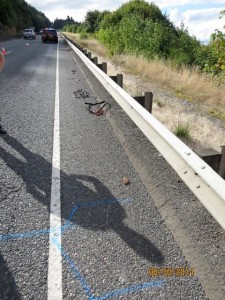A 74-year-old man was killed Saturday while riding his bicycle on the shoulder of Highway 30. It’s the sixth major rear-end collision in Oregon and SW Washington in less than a month — all of which have been caused by unsafe driving.
According the the Oregon State Police, this latest tragedy happened west of Rainier in Columbia County near Oregon’s northern border. Peter Linden was riding westbound near milepost 50 when the driver, 34-year-old Kristopher Woodruff, looked down at a text and allowed his truck to veer slightly into the shoulder where it hit Linden.
Woodruff did not stop and was arrested a few miles down the highway. He didn’t have a valid driver’s license and has been charged with Manslaughter in the First Degree, Felony Hit and Run, and a misdemeanor for an outstanding warrant.
KOIN-TV had a video report from the scene of the collision. They also shared that Linden was a retired city attorney from Saint Helens who was an avid bike rider and cancer survivor.
Of note to advocates, politicians, and concerned citizens is that there are important similarities between the collision that claimed Linden’s life and the other five collisions in this past month:
— In all six cases, unsafe driving behaviors caused the collisions:
- August 13th: Serious injury collision east of Eugene. Driver cited for Unsafe Passing of a Person Operating a Bicycle (ORS 811.065)
- August 13th: Fatal collision north of McMinnville. OSP says “driver fatigue being investigated as a contributing factor.”
- August 14th: Serious injury collision in Vancouver, Washington. Driver was trying to grab a pacifier from the back seat and became distracted. He was cited for driving while suspended and Negligent Operation of a Motor Vehicle in the Second Degree.
- August 16th: Serious injury collision in Grants Pass. Driver was cited for Careless Driving due to an unsafe pass.
- August 24th: Fatal collision on I-84 in Columbia River Gorge. OSP says that, “driver fatigue has been identified as a contributing factor.”
— All the collisions happened on major highways with relatively narrow shoulders (except for the one in Vancouver that happened on an arterial with a bike lane) where driving speeds range from 45 to 65+ miles per hour
— In every case, the person on the bike likely chose their route because it was the only available — and feasible — option to get where they wanted to go.
— The police have done their jobs (at least, after the fact). In every case, the police have either already given a citation, have started an investigation, or have referred the case to the district attorney’s office.
Advertisement
This recent spate of collisions has weighed heavily on my mind because I ride the shoulders of Oregon highways and byways quite a bit. In reading comment sections of media coverage of the collisions, I notice a common response is for people to say, “Riding in these places is dangerous! Bikes shouldn’t be on the highway!” That’s a popular perspective and one that’s more mainstream than you might think.
But, as someone who has logged thousands of miles across Oregon in both a car and a bike, I see it a different way. This isn’t a bike safety problem, this is a car safety problem. In each circumstance — and in hundreds of other rear-end collisions in Oregon (and elsewhere) over the years — the car operator failed to stay in their lane. Bicycling on highway shoulders is completely safe, as long as people drive responsibly and safely.
The constant refrains of “bike safety” and resulting “bike safety projects” that happen after tragedies like these do not do justice to the problem (and a similar thing happens whenever there’s a spate of collisions involving people walking). What if we focused on improving “car safety” and worked on “car safety projects” instead? How would that change in framing impact people’s perspective on the issue and how would it change the way we approach the problem?
The last thing I’ll share today is that the leaders of Oregon and our various transportation bureaucracies have a responsibility to address these issues.
With a growing network of legally designated State Scenic Bikeways, we are encouraging people to get out and ride. This is a great thing because there’s no better way to experience Oregon’s beauty than on a bicycle and there’s an increasing realization that by doing so, local economies reap the benefits.
But it’s irresponsible for Oregon to encourage bicycle tourism — the vast majority of which takes place on the shoulders of highways — without doing more to make sure conditions are as safe as they can be.
I’ll be covering this issue much more in the months to come. I have some legislative ideas I’ve been thinking about for over a year now that relate directly to rural road and highway safety. I’m also heading out to Cycle Oregon next week where I’ll be spending many hours on highway shoulders trying to figure all this out. Stay tuned.
— For more on Oregon’s recent spate of rear-end collisions and the car safety issues they raise, see our coverage here and here.

